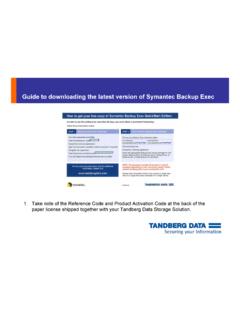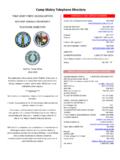Transcription of Guide to Data Protection Best Practices - Tandberg …
1 WHITE with meeting their own needs for supporting data growth, security, environmental, economic needs, and regulatory compliance, businesses today must address the dual challenges of safely storing and protecting their corporate data at a time when the quantity of the information they generate and consume daily has grown exponentially and IT budgets are under even greater scrutiny for cost savings and efficiencies. However, data Protection is a business imperative now more so than ever before; the failure to properly manage and safeguard corporate data can result in business disruption, devastating losses or the potential failure of the business itself.
2 This white paper discusses how businesses must first develop an appropriate strategy and then make the right technology choice from multiple storage options in order to establish best Practices for data , data EverywhereIn 2009, amid the Great Recession, the amount of digital information grew 62% over 2008 to 800 billion gigabytes ( Zettabytes). Digital information created between 2009 and 2020 is forecasted to grow by a factor of 44x. It s also expected that by 2020, the percent of digital information requiring additional security will grow from 30% to 50%. In 2010 35% of digital information created is discarded because we don t have available capacity.
3 This number is expected to grow to 60% over the next several years. The number of files, images, records and other digital information containers will grow by a factor of 67, each needing to be managed, secured and protected. Despite Guide to data Protection best PracticesA Tandberg data WHITE PAPER ON BACKUP AND ARCHIVAL STORAGE best PRACTICESG uide to data Protection best PracticesWHITE PAPER this growth, the number of IT professionals globally will grow only by a factor of The cumulative effect is driving CIOs to seek out new levels of agility, efficiency and control by moving quickly toward private cloud computing environments. Digital information created in 2010 = Zettabytes is equivalent to: The digital information created by every man, woman and child on Earth Tweeting continuously for 100 years 75 billion fully-loaded 16 GB Apple iPads, which would fill the entire area of Wembley Stadium to the brim 41 times.
4 A full-length episode of FOX TV s hit series 24 running continuously for 125 million years. 707 trillion copies of the more than 2,000-page Patient Protection and Affordable Care Act signed into Law in March 2010. Stacked end to end, the documents would stretch from Earth to Pluto and back 16 times or cover every inch of the United States in paper 3 feet of this may not come as a surprise to the executives running businesses of all sizes across the globe. They face a daily deluge of data from every department administrative, financial, legal and operational. And this data comes in a multitude of forms, such as emails, text files, presentations, voice mails, faxes, invoices, employee records, Website content, photographs and even physical samples, such as product samples or historical printed documents.
5 A Convergence of FactorsAt the same time, these businesses must comply with recordkeeping requirements defined by state and federal regulators, their industry and legal precedence. Certain industries have regulations mandating how information must be used, stored and retained before being destroyed, and these retention requirements vary significantly from one type of data to another, according to the Association for Information and Image Management (AIIM). Amid this era of increasing compliance, IT budgets are now even leaner and meaner. Gartner had originally expected IT budgets to grow in 2009, but it has revised that figure downward to between 0% and , with a worst case scenario of Faced with those numbers, total cost of ownership (TCO) and return on investment (ROI) will continue to drive IT budget planning and spending.
6 However, businesses now see that it is essential not just to look at the price of IT hardware, but at the whole product lifecycle. With that in mind, the cost of running and maintaining equipment particularly the energy consumed by each piece of equipment has come under increased scrutiny. According to an IDC report on Worldwide Server Power and Cooling Expense 2006-2010, for every dollar spent on computer hardware, another 50 cents is spent on energy. Within the next four years, that number will rise by 54%. Further, Gartner predicts that this trend will get even worse, with energy costs consuming up to one-third of IT budgets within the next several years.
7 (Source: , SNW: Users Thrash Out Green Storage ) For companies going green, this is as much about maximizing cost savings as it is about saving the this convergence of negative factors, businesses today require 24x7 access to data . Instant access to data is now taken for granted, whether in the office, on the road or working remotely. At the same time, this has become a business imperative because unmanaged or poorly managed data can to data Protection best PracticesWHITE PAPER bury decisions under even higher piles of conflicting data . (Source: Relevance by David Apgar) This lost or hard-to-find information can reduce overall productivity and lead to missed opportunities to grow the business from losing reputation to losing individual sales to losing : The Lifeblood of Any CompanyCorporate data is a strategic asset.
8 Improperly managed, it can become a significant liability. In the case of a litigation request, for example, companies are responsible for producing the required information needed for their defense and this now includes email a result of these developments, businesses and corporate executives have gained a vivid awareness of the need to back up their data as part of their overall business continuity and disaster recovery plan. This includes the regular backup and archiving of data so that in the event of a natural disaster, such as a fire, water damage, etc., they can quickly access another copy of their corporate data and be back in business again as quickly as possible.
9 With the cost of IT system downtime so expensive between $84,000 and $108,000 for every hour the cost of even one day of lost business can be devastating, particularly in today s economy. (Source: Gartner, IDC, Forrester, Yankee Group) In fact, it is reported that 90% of businesses that lose all of their data go out of business within the following 12 months. Remarkably, however, 40% of all small- and medium-sized businesses (SMBs) don t back up their data at all, and 60% of all data is stored on PC desktops and laptops. (Source: Small Business Computing). Looking at small office/home office (SOHO) users, only 73% who have a personal backup device use it to back up at least monthly, and only 40% back up daily.
10 (Source: IDC Worldwide Personal Storage 2007 2011 Forecast and Analysis)Truth or ConsequencesTo protect themselves adequately, businesses must improve how they manage and protect their business records. As new regulatory rules are created and the number of disaster recovery scenarios increase, Information Lifecycle Management (ILM) now plays a pivotal role in helping companies adhere to new standards while incurring minimum management headaches. ILM is not a specific technology. Instead, it is a combination of processes and technologies that determines how data flows through an environment. By doing so, it helps companies manage their data from the moment it is created to the time it is no longer needed.






